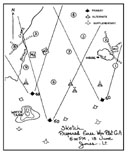the platoon as ordered by the company commander.
The platoon leader keeps himself informed of the locations
of the company command post, the elements of his platoon,
the rifle platoons in the leading echelon of the company, and
the carriers from which his ammunition is being obtained.
When practicable, he supervises the fire of all elements of
the platoon. When direct control of the action of both
sections is impracticable, he supervises the action of one
section as directed by the company commander. He may
designate the platoon sergeant to supervise the other. The
platoon leader is responsible for the supply of ammunition
from the most advanced carriers, or other point designated by
the company commander, to all elements not detached from
the platoon. (See par. 201.)
- Platoon sergeant.--The platoon sergeant is second-in-command.
During movement he marches at the rear of the
platoon and prevents straggling. During combat he takes
charge of either weapon section when directed by the platoon
leader; otherwise, he keeps constantly in touch with the situation
to the rear and flanks of the platoon, supervises ammunition
supply, assists the platoon leader as directed in observation
and control of fire, and in displacements follows the foot
elements of the rearmost echelon.
- Transport corporal.--The transport corporal is in direct
charge of the weapon carriers. He is responsible for their
protection and the supervision of first echelon maintenance.
For duties in connection with ammunition supply, see
paragraph 201.
- Messengers.--One messenger accompanies the platoon
leader; another reports to the company commander when the
company takes up a deployed formation. (See par. 8b (8).)
- Chauffeurs.--Under the supervision of the transport
corporal, chauffeurs conceal and camouflage their carriers at
all halts. When separated from the sections, chauffeurs protect
the carriers with automatic rifles or with their rifles,
depending upon the equipment of the carriers. They are
responsible for first echelon maintenance.



